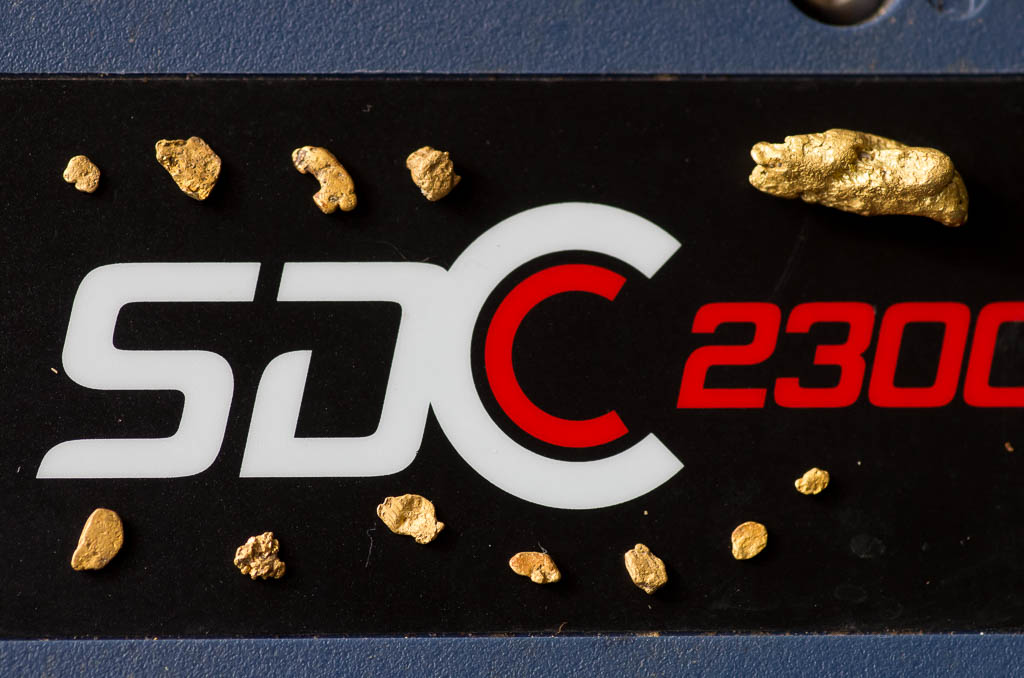Tasmania has a reputation as a mediocre place to detect for gold. We have a reputation for scarce nuggets and for being a place place where only fine gold can be found. However, gold nuggets larger than once ounce in size have been found in most of our goldfields. In fact only the Lisle / Golconda area was notorious for the scarcity of nuggets over 1 dwt (1.5g) in size, and the almost total absence of specimens (gold with quartz attached). If you’re doubtful, check out the list of historical Tasmanian gold nuggets I put together.
Historical large nuggets
The largest two gold nuggets ever found in Tasmania were found within a short time in the same stretch of the Rocky River near Corinna, in 1883. I briefly described the find in my previous post about the Mt Huxley swindle, and plaster casts of these nuggets are featured in the cover of Ralph Bottrill’s publication Alluvial Gold in Tasmania.
Most people in Tasmania have heard of these, but many other sizeable nuggets were found in the early gold rushes. A list is provided in the Alluvial Gold booklet, and I gave some links in my post on northeast gold, but finding evidence of others takes going back to the original newspaper reports, which I’ve started doing in my Tasmanian Gold Nuggets database.
Legality of gold detecting in Tasmania
The use of metal detectors for prospecting is not regulated in Tasmania. This means that they’re neither specifically allowed, nor forbidden. Even though this is a less-than-ideal situation, since there’s no specific ban, there is no restriction in their use for non-prospecting activities.
As I already went over previosuly, the Mineral Resources Development Act of 1995 defines prospecting as “to explore for minerals to a depth of less than 2 metres below the surface of the earth or of any pre-existing excavation by means of a hand held instrument”. If a bloody-minded inspector hassled you, you could easily argue that a detector is a hand-held instrument. Also remember that there’s nothing stopping you from looking for relics, which the mining inspectors have no authority over. So far there is no indication that authorities have any particular dislike of metal detectors. In another twist of our weird and wonderful Tasmanian mining law, there is a ban on carrying out “aerial geophysical surveys” without the approval of the Director of Mines. The maximum penalty (as of mid-2015) is $77,000. So, does gold detecting in Tasmania constitute ‘exploring with a hand-held instrument’, or instead, ‘carrying out an aerial geophysical survey’? For the sake of sanity we’d have to assume it’s the first.
Where can you go, and do you need a licence?

It is debatable whether prospectors in Tasmania own anything they find.
There are, as of 2015, no dedicated fossicking areas set aside for gold. Because of this, Mineral Resources Tasmania will tell you that you need to get a prospecting licence, which costs $30 per year, and gives you permission to look around. Keep in mind that, in Tasmania, the mines department is of the opinion that you will NOT OWN any gold or minerals you find, even after you purchase a prospecting licence.
Pretty much every part of the state that has had gold found in it is covered by tenements, so you’ll also need to arrange for permission to prospect there. Even though it sounds tedious, once you’ve obtained the right permissions, you can detect in most of the State. The only good area in Tasmania that is completely out of bounds today is the Jane River goldfield. This was the last goldfield to be discovered in the State, and became a part of the Franklin-Gordon Wild Rivers National Park, and is nowadays part of the Tasmanian Wilderness World Heritage Area. Every other major goldfield in Tasmania is open to prospecting (provided you get permissions organised, if needed).
Choice of metal detector
This is one of the most common questions that I get asked, and also one of my main questions to others when I was starting out: What detector should I get for gold detecting in Tasmania? It’s a little like asking: How long is a piece of string? Well, it depends!
- What’s your budget?
- Are you going to be going out often?
- How committed are you?
- How hard do you want to work?
- Are you interested in gold detecting only or also coins and relics?
- Will you travel to the mainland or use it only, or almost only, in Tasmania?
There are all kinds of websites that offer comparisons of detectors, and most or all prospecting forums have sections for members to ask questions like “what detector should I get?”. I personally find Steve Herschbach’s Guide to Gold Detectors very useful (he keeps it up to date), and among Australian online forums I like Prospecting Australia and the Gold Detecting and Prospecting Forum.
Technology
In summary, the older and cheaper technology for metal detecting is called ‘very low frequency’, shortened to VLF. All early detectors used this technology, and many thousands of ounces of gold have been found with it. Don’t believe people who say that you can’t find gold using a VLF metal detector. On the otehr hand, you won’t have an easy time of it: people have been gold detecting in Tasmania with VLF detectors for 40 years, and most gold that was easy to find has been found. BUT… they never get it all, and if you’re prepared to put the effort in, you’ll be rewarded. People are still detecting gold in Tasmania using VLF detectors. For example see Philski’s posts on his Tas-Prospecting forum.
The newer technology, which many people say has ‘re-opened the goldfields’, is Pulse Induction, or PI. It punches deeper, and runs much quieter than VLF. However, until recently it had trouble detecting gold as small as a VLF can, and isn’t as good as discriminating gold from trash as VLF. There are a couple of posts on the Gold Prospecting in WA blog that explain the differences in more detail.
Considerations
Anyway, if you’ve asked yourself the questions I set out above, here’s how they might affect your choice:
- Budget: as of mid-2015, a good VLF gold detector can be had for under $1,000 new, whereas a good pulse induction unit will set you back at least $2,000, up to $10,700 for the top of the range Minelab GPZ7000. A decent, secondhand Minelab GPX4000, which was top of the range a few years ago, can be had for ~$2,500–$3,000. A re-released Minelab GPX4500 costs just a shade over $4,000 and is a great mid-range gold detector. Whites have a couple of well-priced PI detectors that have a decent reputation.
- Frequency of use: How often you’ll be going out will affect how much you’re prepared to spend: if you only mean to use it occasionally, it’s hard to justify dropping ten grand on a toy. However, if you’re on an awesome patch and you think you might take out a lease, or you plan to spend a lot of time detecting and perhaps partially live off it, the better the detector the more gold you’re likely to end up with (all other things being equal).
- Commitment: similarly, if you know you love it, you might be more prepared to drop a significant chunk of money than if you’ve never tried this and you want to see if you like it.
- Ease of use: the more expensive PI detectors can have a steep learning curve (not all of them), but once you know how to use them, they suffer a lot less problems than VLF in dealing with mineralised ground, etc. Detecting with a VLF can be frustrating in difficult ground. The mineralisation changes will have your detector squealing, beeping and giving all sort of false signals on barren ground and hot rocks. In comparison PI detectors usually ignore the soil mineralisation and hot rocks. For more on hot rocks, read these Treasure Talk articles on the Minelab website.
- Specialisation: If you’re only interested in looking for gold, get a dedicated gold detector. Gold detectors on average tend to be more expensive than treasure detectors. For example a top of the range Minelab CTX3030 treasure detector will set you back about $2,700 (in Aug 2015), whereas the top of the range Minelab GPZ7000 gold detector will have you forking out $10,700. Some decent dual-purpose machines can be had for $1,000–$2,000, but they all trade off something to be good at both, generally.
- Local use only? In Tasmania, portability is important. Many of our goldfields don’t have good road access, particularly on the West Coast. Also the scrub is so thick in most of our goldfields, that a small coil is very helpful. This trades off on the ability to find deep, large nuggets, because the depth you can get out of your detector is directly related to the size of your coil. Small coils are more sensitive to smaller gold also.
What do I use for gold detecting in Tasmania?
I detect almost exclusively in Tasmania, and I have a Minelab SDC2300. This is a gold-only pulse induction detector that folds up into a small parcel. I can fit it into a backpack with three days of food, camping gear and prospecting gear, and reach some pretty out-of-the-way places. It also has a small 8-inch coil which can fit in between the vegetation and makes detecting overgrown areas much easier.
However, if I go and spend some time in mainland gold fields where the scrub is not such a pain and the access is a lot flatter, I’d consider borrowing or renting something like a GPX5000, and using a large coil to get the extra depth.
I know of people right now in Tasmania that are finding gold with machines like the Minelab X-Terra 705, which I have seen on special in outdoors stores for as little as $685. It’s more difficult than finding gold with a whizz-bang machine, but at the end of the day the biggest single factor that will determine how much gold you find will be time you spend with the coil on the ground.
It can take years to get good at gold detecting, and learn to read the terrain, and leard where to persevere and not to waste your time. Keep at it, and don’t get discouraged if you don’t find any gold for a while. We all started out knowing nothing, and I detected for a whole year before I found my first nugget! Nowadays I rarely come home empty handed.
Did you find this useful? Is there something about gold detecting in Tasmania that you’d like to know about? If you like the content at Apple Isle Prospector, feel free to get in contact, or leave a comment.


G’day Miguel, just wanted to reassure you and anyone else concerned that if any part of you is touching the ground while you’re holding a metal detector, you’re not conducting an aerial geophysical survey as far as MRT is concerned. The clause you refer to in the Mineral Resources Development Act 1995 is really only talking about surveys carried out from fixed wing, helicopter or drone platforms. Accordingly, I guarantee you will never be fined $77,000 just for using a metal detector!
I’d also add that a detector is certainly a hand-held instrument and thus permitted for use in fossicking and prospecting, particularly since in all but extremely unlikely circumstances, the effective penetration depth of metal detectors is less than two metres.
Mark Duffett
MRT geophysicist
Hi Mark,
Thanks so much for taking the time to comment and clarify the situation. Not that I think anyone seriously thought getting fined that way was a realistic possibility. I guess a clause written in 1995 could not contemplate future disruptive technologies like drones. Metal detectors were much less widespread in Tasmania back then than they are today.
Thanks again for commenting!
Talking about aerial geophysical surveys, I worked out how to put regular geographic features over the top of a MRT ‘magnetics basemap’.
I couldn’t do this on ListMap but that doesn’t mean in can’t be done. Having the magnetic data with roads, creeks and towns seems to make magnetic maps a bit more familiar and not such a mystery.
I think the Magnetics basemap with ‘mineral occurrences’ is a fantastic resource and its good this info is freely available.
http://west-tamar-talk.blogspot.com.au/2015/10/aerial-metal-detecting-understanding.html
Hi Karl,
Looks much easier to interpret with the features, it’s a shame they don’t make the magnetics available as a layer, rather than a base map, or the base map available as a layer, so it can be overlayed and its transparency adjusted. Would make things much easier.
Gold in Tasmania is associated with Cambrian ultramafics (serpentinite, etc) on the west coast, Adamsfield, Maydena, south coast and Flowery Gully, but also with Devonian acidic rocks (granite) in both eastern and western Tasmania. The reason that the vegetation is so sparse in ultramafic areas only partly toxicity, but also the fact that they break down to very nutrient poor soils. Interestingly, serpentine-derived soils are botanically very different from surrounding soils, and often contain plants found nowhere else!
Hi Tasprospector, It has been great to visit your website and very interesting as well. We have visited Tassie on 3 occasions for a total of 6 months spent there and we love it. We haven’t tried detecting there but now we have seen your website we might get back there one day. We have been aware of gold in Tassie having been around the NE, and the west coast between Corinna and Arthur River. Great looking country. I will put your website in favourites and continue to explore it. Cheers, Jim
Thanks Jim,
Detecting down here is a different challenge to in the mainland. Our soil is often too deep, and our nuggets not as big. However, our mullock has been less flogged, and our creeks often have flowing water and visible bedrock, and also have got less attention.
I’ve got my best Tassie gold from old workings and active riverbeds.
Good luck when you get down!
Hi Everyone.
Can someone please give me a definitive answer (if possible) on the legalities of detecting on Tassie Beaches. I have visited the ListSite you mentioned above, but the overlays are more confusing than ever.
I also then read on a another forum from a guest contributor that detecting on all Tassie Beaches is OK?
Please advise
Thanks in advance
Deano
Hi Dean,
If by ‘definitive answer’ you mean ‘yes’ or ‘no’, you’ll be disappointed, because it depends.
IF the beach is public property AND not in any kind of reserve then you could detect for coins and relics. IF you have a prospecting licence you MAY be able to prospect for gold, although the use of metal detectors for prospecting is not covered by any kind of legislation or rule in Tasmania (other than laws banning detectors in reserves).
You can detect for coins and relics inside private property anywhere with the owners permission. Beaches in Tasmania are mostly public land but not always, so you still need to check.
There really is no simple yes/no answer.
Hi..Fantastic information you release. Thankyou so much..Could you share some information on the correct process of how to obtain permission from Exploration Liscecse holders..My partner and i are heading up too Le Froy to catch up with friends and were going to potter around with our metal detectors and do a bit of fishing. We both have prospecting liscences..Thankyou so much..Phil Sarossy
Hi Phil,
You can use MRTmap to overlay exploration licences and find out the contact details of licence holders. I think I go over how to get that information in the video here.
As to how to go about contacting them, whatever you prefer. You can email them, or phone them… Many never reply no matter what, others say no, but the responses I’ve got so far have been fairly positive.
Good luck!